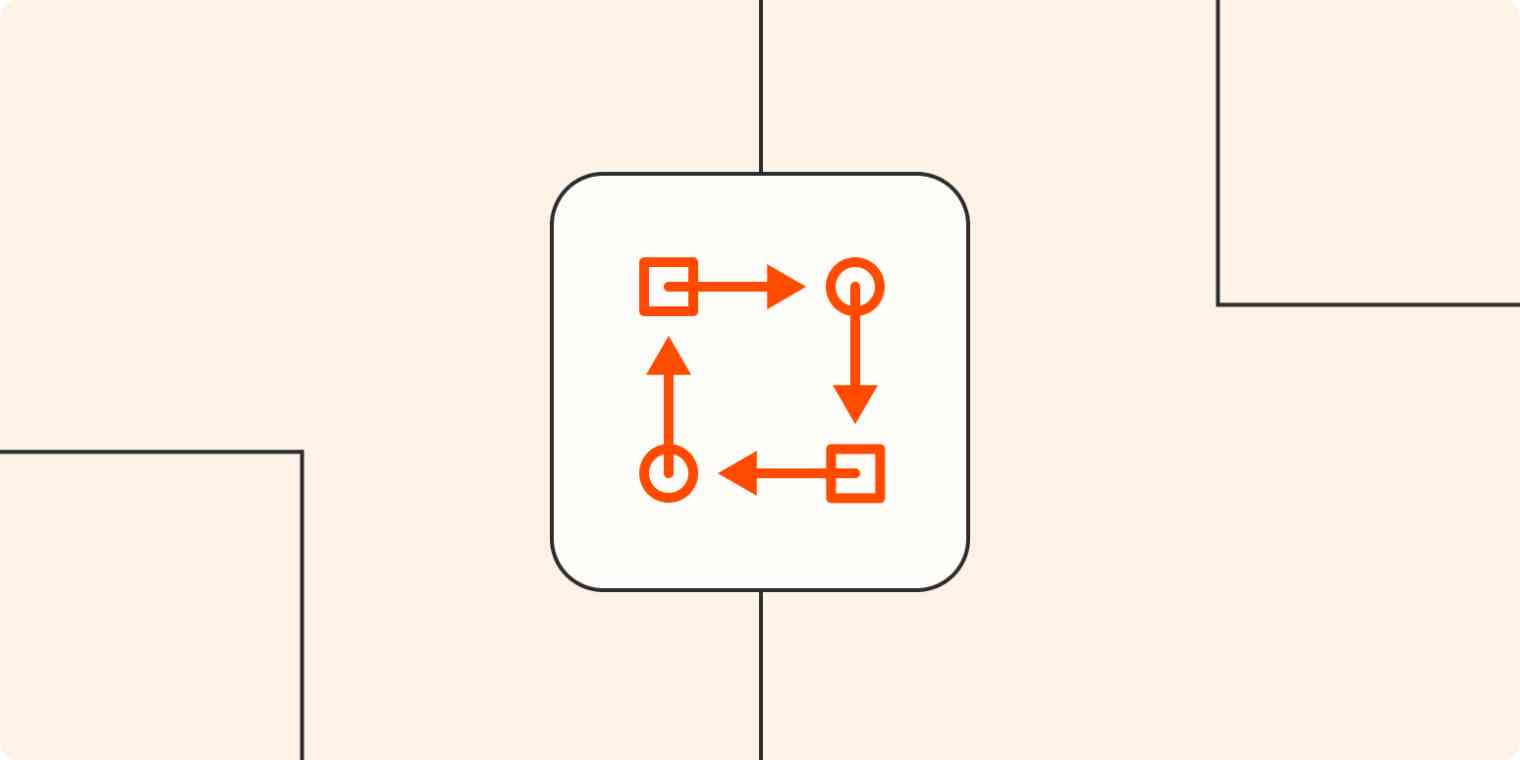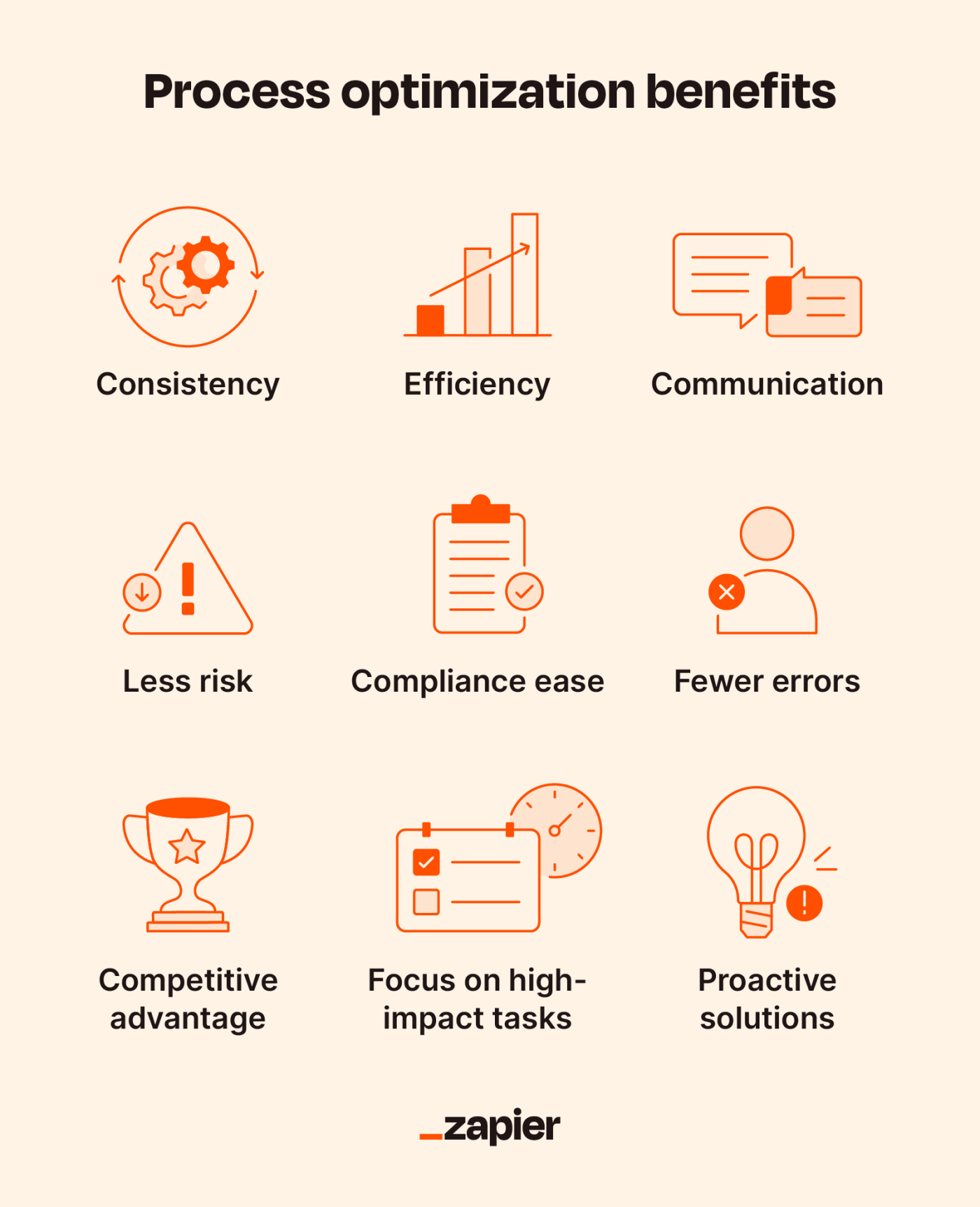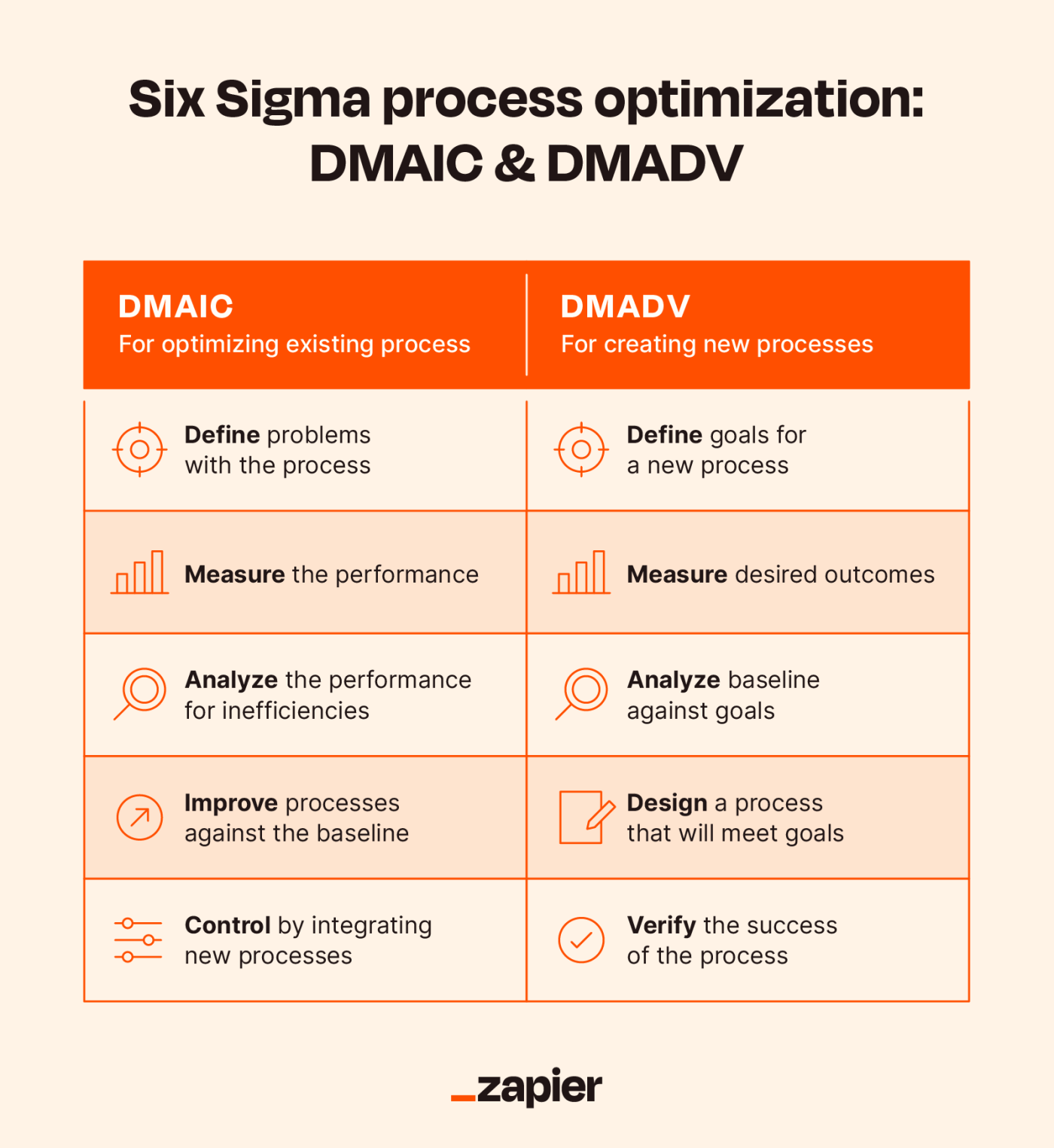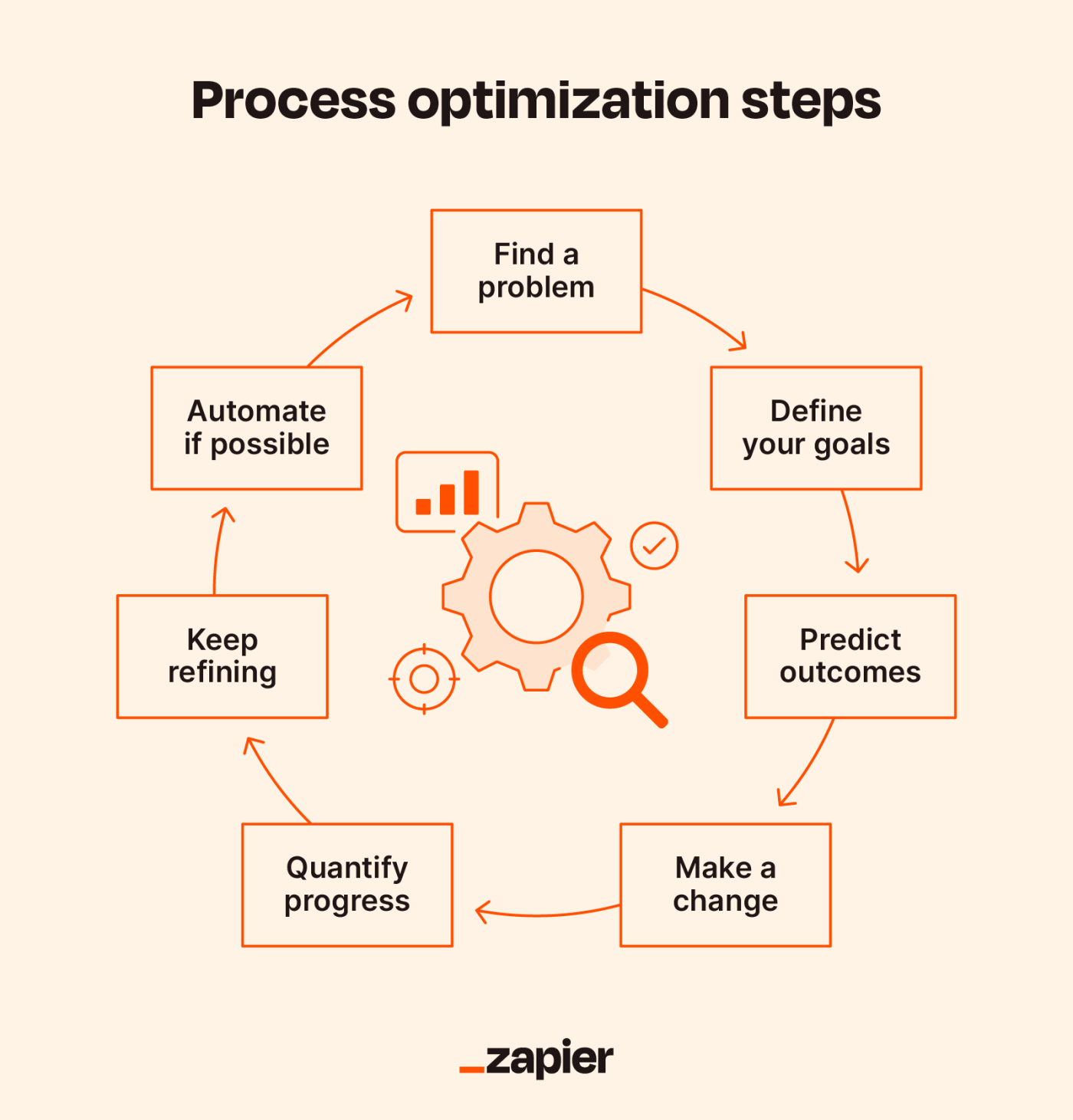

The only thing more dangerous than someone with disproportionately more confidence than competence is that same someone with a power tool.
Exhibit A: after an especially frustrating hour-long struggle to hang a curtain rod in a level manner, I thought long and hard about where things were going wrong. My process of holding the rod precariously against the wall with one hand, struggling to keep it straight while balancing a tiny plastic level, and painstakingly driving holes in the plaster with a cheap drill and even cheaper bit wasn't cutting it.
Streamline work across departments with automationLong story short: I bought a laser level, an impact driver, and better drill bits, and now the stuff I hang is consistently about 90% level if you don't look at it too long—and I can do it in about a quarter of the time.
This is process optimization at its finest, and the same concept can be applied to great effect for your business.
Table of contents:
Process optimization involves identifying and fixing inefficiencies in regular procedures to improve efficiency. Businesses often invest in improving processes to increase output, cut down on unwanted work, and turn a greater profit.
It may sound simple, but it can take a lot of time and expense to put into action. That's why existing process optimization frameworks can help you find those holes in your business operations and patch them up, saving massive amounts of time and money that you can put toward more high-impact work.
Whether it's streamlining HR procedures, saving money, or automating lead generation, the ability to optimize business processes is something every business manager needs in their toolbelt. Keeping recurring tasks and complex procedures running optimally comes with a bevy of big benefits.

If the process of "optimization" sounds vague to you, that's because it is. Instead, you can use these established (and non-vague) optimization frameworks to identify and correct workflow hiccups.
No, I'm not talking about what my picture frames do. Lean is a general approach to project management that improves efficiencies and bottom lines by cutting waste. The broader Lean framework can encompass many techniques that can vary by industry, but specifically, Lean project management helps stop:
To get Lean, you'll need to follow these five steps:
Process in action: A nature book publisher is looking for ways to reduce overhead. Their most popular titles are hiking guides, but demand ebbs and flows seasonally, and the market is price-sensitive. Through value stream mapping, they realize they can save money by cutting down on defective books and storage costs. They decide to offer their guidebooks as full-color digital eBooks at the same price and shift print production to on-demand while shifting from color to black-and-white. Books are only printed when someone orders them, and combined with eBook sales, they manage to cut production costs and storage costs without increasing prices.
Best for: Cutting waste in workflows, production, and other processes
A SIPOC diagram creates a handy visual representation of your business processes. It helps decision-makers see the bigger picture and identify opportunities for optimization, so they can better align them on the metaphorical wall. SIPOC stands for:
Process in action: The owner of a bakery looks at the viability of a specialty sandwich with a partnered butcher. They make a SIPOC diagram to identify the Suppliers (bakery owner, butcher, ingredient supplier), Inputs (new recipe, specialty meat, supplemental ingredients), Process (sourcing ingredients, ingredient prep, cooking), Outputs (new menu item), and Customers (bakery owner, butcher, customers). They use the diagram to help streamline ingredient exchange and sandwich preparation, align budgets, and set a price point.
Best for: Gaining high-level understanding of a process
Similar to data mining, process mining scrapes existing data to discover patterns, chart your current business processes, and back them up with real numbers.
Process in action: A healthcare provider uses data mining software to comb through logs of time-stamped events, including calls, appointment schedules, sent invoices, and paid invoices. Mining real data—including consistently updated current data—shows key points where scheduling and invoicing can be improved to improve patient retention and cut down invoice payment time.
Best for: Applying definite numbers to existing business processes for further analysis
Originally devised for Motorola as a mathematical approach to quality control in manufacturing, Six Sigma is also a useful Lean technique for cutting down on waste, boosting accuracy and overall efficiency, and improving predictability.
The word "sigma" refers to a standard deviation, the extent of how spread out or variable something is. So, Six Sigma refers to a controlled process that's within six standard deviations of the mean and leads to an average of 3.4 defects per million opportunities.
Six Sigma can also be used in Agile project management. Agile's fast-paced approach to continual software delivery rewards preventing issues before rolling out new features.
Depending on whether you're improving an existing process or creating new ones, there are two acronyms you can use to apply Six Sigma: DMAIC and DMADV.
As a method for improving existing processes, DMAIC stands for:
If you're creating a new process, you can apply Six Sigma through DMADV:
Process in action: A printing company has to find a way to deal with increasing material costs for a price-sensitive market. Using DMAIC, they find that they can save money and increase revenue by updating their facility to cut down on printing defects.
Best for: Conceptualizing solutions for definable problems or designing new processes

You can use value stream mapping to frame a current process into a convenient flowchart. Like a SIPOC diagram, this Lean-friendly visual aid helps you see things as they are so you can find opportunities for improvement. VSM turns complex processes with abstract costs and resources into clear outlines with defined values.
To create a VSM, list each step in a given process. For each step, note the amount of time and any associated expenses required, along with whether it adds value (and if so, how much) for the end user. Once you can see the process laid out in clear values, you can design a better model that cuts out steps that take too long or cost too much to justify their value.
Process in action: A marketing company is looking to cut down on delivery times for their customers. A manager uses VSM to chart the production process from lead to delivery and finds that by restructuring their concept phase, they can streamline cross-department communication and 10 non-billable hours from every project.
Best for: Visualizing complex processes and finding wasteful steps
Not to be confused with the five Y's, five-wise, or the much more delicious Five Guys methods, the five whys technique for problem-solving trades theoretical decision-making for facts. Once you've identified a problem, the process is deceptively simple: ask "Why?" five times. It's a strategy parents with toddlers know well and have likely worked hard to erase from their memory.
What makes this approach effective is that it forces you to stay grounded in facts and proof. You're not responding with what might be happening; you're responding with what did happen that caused the problem.
With every "Why?" you answer, you get closer to the core of the problem. Once you have a specific answer, ask why that answer is true. Repeat until you arrive at the final matryoshka doll of an answer. Fixing that final problem could solve the broader issue you started with four whys before.
Process in action: Sales of a productivity app were underwhelming during the developer's back-to-school sale. They use the five whys to find a likely reason students wouldn't follow through on a free trial signup. Why #1: Signups for the free trial were low. Why #2: Conversions on the landing page were low. Why #3: Many users abandoned the signup process. Why #4: Over 60% of users left after the first page of the signup form. Why #5: The second page of the signup form required credit card information. They decide to cut the credit card input requirement and redeploy the campaign later in the semester.
Best for: Finding the heart of a complex problem
Not to be confused with the five Y's—a term I made up in the last section—5S is a practical Lean model that creates more efficient and orderly physical workspaces. Each "S" is based on a Japanese term that conveniently also starts with an "S" sound.
Process in action: After moving into a new space, a growing startup company quickly fills it with new gear, new workstations, and new hires. They get rid of outdated equipment (Sort), stock a newly empty closet with office supplies (Set in Order), hire a cleaning company to do a deep clean over the weekend (Shine), schedule cleaners to return every week (Standardize), and implement biannual "stuff audits" to keep the clutter down (Sustain).
Best for: Creating an orderly working environment
Sometimes referred to as PDCA (replacing "study" with "check"), Plan-Do-Study-Act is a Lean method for gauging the effects of a change. This won't help you find new solutions or identify problems, but it can prove whether your process optimization solutions have the desired effect. Here's the four-step process:
Process in action: A travel company is seeing lower open rates on their marketing emails and wants to ramp up engagement with summer approaching. They decide shortening subject lines and adding emoji may help increase open rates, aiming for at least a 15% improvement (Plan). Over three months, they A/B test by segmenting half their contact list at random to receive the same emails but include longer, text-only subject lines for Group A and short subject lines with emojis for Group B (Do). After three months, they notice 23% higher open rates for Group B (Study). Going forward, they set subject line guidelines for a shorter maximum character count and make it a policy to include at least one emoji for all marketing emails (Act).
Best for: Proving the effectiveness of a specific change
True to its name, Total Quality Management takes a holistic philosophy for improving performance, deliverables, and/or customer experience by finding and correcting issues and empowering employees. TQM is an ongoing process that cuts down on errors, improves efficiency, and ensures employees at all levels have the resources they need to execute. When implementing TQM, there are a few general guiding principles to keep in mind:
Process in action: An edtech company is losing ground to key competitors on similar software with greater functionality and a similar price point. Guided by TQM, they perform a full audit of every department to find internal growth opportunities. Management teams attend seminars on process optimization, sales teams get monthly training from external professionals, marketing teams are given a budget to overhaul the website, and product teams meet with college instructors to learn how their product can be changed to better meet customer needs.
Best for: Creating a framework for continuous improvement
Workflows are procedures for finishing a repeatable task, and workflow analysis breaks these procedures into specific activities to find areas for improvement. Workflow analysis visualizes each task in a workflow using flowcharts, value stream maps, swimlane diagrams, and business process maps (a more detailed flowchart that highlights relationships between tasks and factors in resources and subprocesses).
Process in action: A business selling a content management system needs to juggle sales, support, and internal tasks. When customers call in for support, agents don't have direct access to the sales data from the user's transaction. As a result, support agents waste time calling sales staff for information. A workflow analysis would highlight this and show how sales and support staff can store information in one easy-to-read dashboard. This cuts down on the average call time and gives support agents the data they need.
Best for: Cutting down on wasted effort and resources in repeated tasks
Zapier Canvas lets you plan and diagram business-critical workflows, then optimize them with AI—all in a single platform.
The Kaizen method involves making incremental changes—instead of one larger improvement—to foster longer-term growth without interrupting workflows. While it was designed for manufacturing, software teams have embraced it, too.
Process in action: A company sells automated bookkeeping software. At first, the product struggles to compete with established brands. Using the Kaizen approach, the company methodically adds new features one by one. After adding small features for a year, the tool can perform complex accounting functions that compete with the big name apps.
Best for: Long-term planning and avoiding dramatic changes all at once
You conduct business process outsourcing (BPO) when contracting a third party to handle your processes. For dedicated teams that focus on a specific kind of task, BPO keeps them from spreading themselves too thin. Generally, companies outsource:
Process in action: An online fashion resale platform relies on an in-house team of web developers and shipping specialists, but they don't have the resources needed to build a payment platform. So, they outsource a third-party billing company to handle those processes. In exchange, the fashion company pays a monthly fee for their service.
Best for: Processes you can't manage alone

No matter which of these process optimization techniques you choose to explore, there's a pretty general overarching structure to process optimization you can expect to work through:
Process optimization offers great benefits, but it requires some trade-offs. Keep these challenges in mind to ensure you start with your best foot forward.
Software can make process optimization tactics both easier to implement and easier to adopt. From task management and visualizations to automation, these solutions can help you simplify, streamline, and cut waste. With these platforms, your team can focus on high-impact work.
Zapier is the leader in workflow automation—integrating with thousands of apps from partners like Google, Salesforce, and Microsoft. Use interfaces, data tables, and logic to build secure, automated systems for your business-critical workflows across your organization's technology stack. Learn more.
Like home improvement, process optimization is never-ending. In a house, there's always another wall to paint, another piece of furniture to replace, a crack that needs filling, a mirror that needs hanging. The same is true of any business and organization (metaphorically speaking). The key is to always be working toward better, more efficient workflows and procedures through smarter workflows, insightful analytics, considered changes, and—ideally—automation.
Related reading:
Get productivity tips delivered straight to your inbox